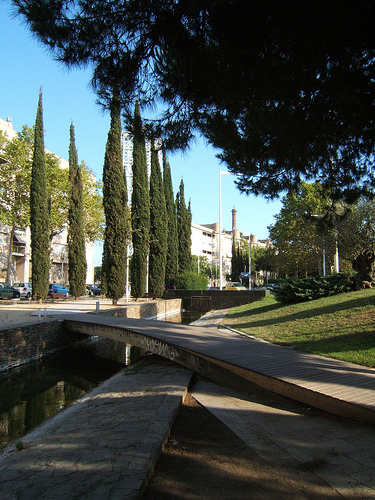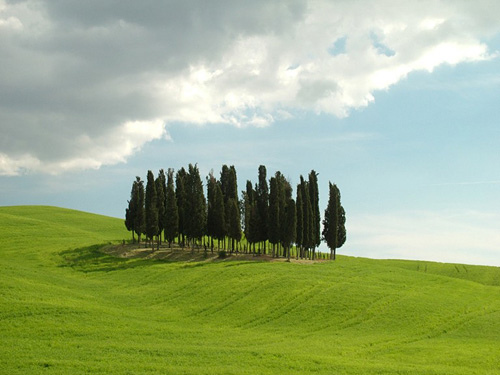Italian Cypress

Gardening Question from Debbie:
We live in the vineyard area in Temecula and have a Mediterranean style property with a long winding driveway and thought planting Cypress along both sides would be a nice focal point leading up to the house.
Here are my questions for you:
- Re: water requirements; I have read two conflicting issues; one I read said that newly planted cypress need to be watered once PER day for the first month to help the root structure; another article said once per month for newly planted Cypress. ??? Which is correct?
- Do we need to stake newly planted cypress? I have read both ~ to stake and not necessary to stake? Which is true Pat?
- Which variety should we get for our area? and what size is best? I like the smooth looking slender variety,,,
- I heard that we should top/prune the tree top when young to produce a stronger root system???? Won’t that damage the tree? I thought “topping” is a no-no.
- Lastly, how far apart should we plant the trees for a long drive?
Thank you in advance for your expertise; always appreciated.

Photo by Sangre-La.com
Answer from Pat:
I love the idea of planting Italian cypress along your long winding driveway. This would be reminiscent of Tuscany and it would be lovely also to plant a grove of olive trees nearby on the hillside so you could look through them to the view beyond.
All trees need frequent deep watering after planting. Also check the drainage in the planting holes prior to planting and additionally soak the holes again before putting in the trees. This avoids the problem of dry surrounding soil pulling water out of the root ball of the trees. if you are planting in heavy clay, be sure to dig about half a coffee can full of gypsum into the earth on the bottom of the hole to increase drainage. It’s also a good idea to place some slow-release plant tabs (such as landscapers use) on the bottom of the hole to fertilize the tree during it’s first year of life. Be sure to loosen up the roots prior to planting if the plants have been in the cans for some time.
My recommendation for watering are no different than for any other tree: Water deeply after planting. Water again the next day deeply and again the next day if rain doesn’t fall. Then water 3 times a week for the next week, twice a week for the following two weeks and after that you can water once a week deeply for the first year or two. After that you can lengthen out the irrigations. In clay soil you might not need to irrigate as much as this but you want to make sure the water goes deeply into the ground since these are deep-rooted trees. Most people err on the side of under-watering newly planted trees and then wonder why they don’t take off as they should.
If I were you I would not stake these trees. if you notice them leaning after a wind, stick them upright again, but this usually won’t happen once the roots are out in the ground. Allowing the trunks to blow about a bit greatly strengthens them. If you have to stake, make sure to do so in three directions so the trees can move. But I don’t think you will need to.
I am glad to hear you like the smooth slender variety since that’s the one that’s easier to get right now. I recommend you purchase ‘Mondale’ Italian cypress—a compact variety but eventually it will grow tall— and make sure your nursery orders them from Monrovia Nursery. If you want to see these, go look at Rogers Nursery and tell them I sent you. You could also go look at Briggs Tree Farm and see what they have matched of the size you want. If I were you I would not purchase any larger than 5 gallon size.
I would not pinch back the tops of these trees until and unless they have reached the height you want. Finally, regarding the distance apart to plant them, that’s up to you. Some people like to create a wall of trees, but I think it looks better to allow for space between them and a chance to look out through them at views and also through them as you look at the drive winding up the hill. I suggest looking at photos, for example in books on Tuscany, and also viewing other similar avenues and see how you like the look. I hesitate to make this choice for you but suggest at least 8 feet apart might be a good choice for this compact variety. Six feet apart might look a little too close as the trees grow, but ten feet apart would fit the old wider variety better than this one. Before deciding I would try to view some similar avenues if I could do so.
Pat
Photo by Francesc_2000 


I have 4 Italian Cypress. All of them are turning brown. We have had them for only 5 years. They do not have bugs nor is the bark oozing. What is wrong? Our nursery guy said he thought they were getting watered with salty water, but that’s impossible. We do not have a pool nor has there been any salty water nearby. Can you help? I live in Northern CA. near San Francisco, in the East Bay. Thanks.
You do not give me enough to go on to tell you what’s wrong with your cypress trees. Italian cypress are unfortunately prone to many diseases and pests. Among diseases Coryneum canker disease is one of the worst and has been killing the lovely Italian cypress trees in Italy, but usually one sees oozing sap and lesions on trunk and branches, which you say is non-existant on your trees. Has there been bad smog where you live? Smog damage is another possible cause of all-over browning. This has been a very dry winter. Are you sure your trees are being deeply watered and that they have adequate nitrogen? If you are relying in a drip system, this most likely would not deliver enough water and also might not water deeply and thoroughly then to be followed with a dry period. Italian cypress in general do not do well on this kind of watering. They need deep and infrequent irrigation, not shallowly and often. On the other hand, do they have good drainage? Cypress trees are susceptible to root rot and this can turn them brown. If they are growing in alkaline clay soil, applications of gypsum can help drainage. You claim that your trees are not afflicted with pests, but some pests cannot be seen. For example leaf miners can afflict twigs and cause browning all over. Other problems that can cause browning include scale, borers, twig and needle blight, tip moth, spidermites and aphids.
hi. I have a very healthy cypress tree at the corner of my home. It is leaning and the home owners association wants me to remove it. I just want to prune it. What should I do?
Sometimes home-owner associations are not very wise. Many trees lean. However if this is the type of tree that is supposed to grow vertically perhaps the problem could be corrected by staking and roping it into position. I would consult an arborist if I were you.
Hi Pat
Sounds like you’re an expert on Italian cypresses! I have 6, which I planted two years ago. Last year they produced huge numbers of cones which make the branches heavy causing them to flop over. Do you know why this is? I’m concerned it may be because they are stressed? I would like to keep the columnar shape and I wonder whether it’s okay to cut these branches?
Kind regards
Clare (UK)
Yes, many cones mean stress, inadequate deep watering and possibly drought. By all means you could have them pruned into smooth columns, cones removed and branches pulled back into line. Some people wire them back into line being careful not to harm or restrict the bark or trunk. Chopping them off can ruin the shape. Be careful who you have do this job and maybe oversee it yourself. I have seen Italian cypress beautifully smoothed out and re-shaped by intelligent shearing and removal of cones, but uneducated three trimmers can totally botch the job.